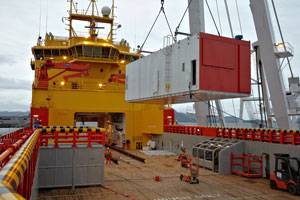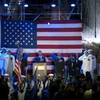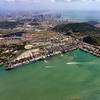First Ship with High Temperature Fuel Cell
September 2009 saw the initial operation of the first high temperature fuel cell to be run on board of a ship, within the FellowSHIP research project (Fuel Cells for Low Emission Ships). The HotModule supplied by the Tognum subsidiary MTU Onsite Energy GmbH Fuel Cell Systems is scheduled for service on the offshore supply vessel Viking Lady, operated by the Norwegian Eidesvik shipyard, so as to verify its suitability for green on-board power generation by means of fuel cells. The HotModule is fully integrated in the existing on-board power generation infrastructure and supplies 320 kW of the current power supply requirements, whilst being powered by liquefied natural gas (LNG).
The objective to launch the FellowSHIP project was to test fully integrated onboard fuel cells - both on board of vessels, as well as offshore platforms - and to make them commercially viable. Under the auspices of the classification society Det Norske Veritas, participants in this project include MTU Onsite Energy, as well as a number of companies like Wärtsilä Ship Design Norway, Wärtsilä Automation Norway and Eidesvik Offshore ASA.
The integration of fuel cells serves to significantly reduce health-hazardous and climate-critical emissions in this project: a total of 4,755 tons of carbon dioxide (CO2), 33 tons of sulfur dioxide (SO2), as well as 180 tons of nitrogen oxides (NOx) can be avoided this way every year, equaling the emissions of almost 20,000 private cars. The electrochemical process mainly generates water and heat. It is predominantly sensitive environments like offshore regions or harbors subject to heavy emission runoff, where these environmental benefits come to full fruition. Since two thirds of global cargo transportation is seaborne, this green fuel cell technology offers a vast potential for emission reductions.
The electrical efficiency of the molten carbonate fuel cell (MCFC) ranges at almost 50%, which - in combination with the effective outgoing heat - results in an overall efficiency of up to 90%. During the coming months, the demonstration system on the Viking Lady will undergo extensive offshore supply operational trials under real seaborne deployment conditions.
(www.tognum.com)












